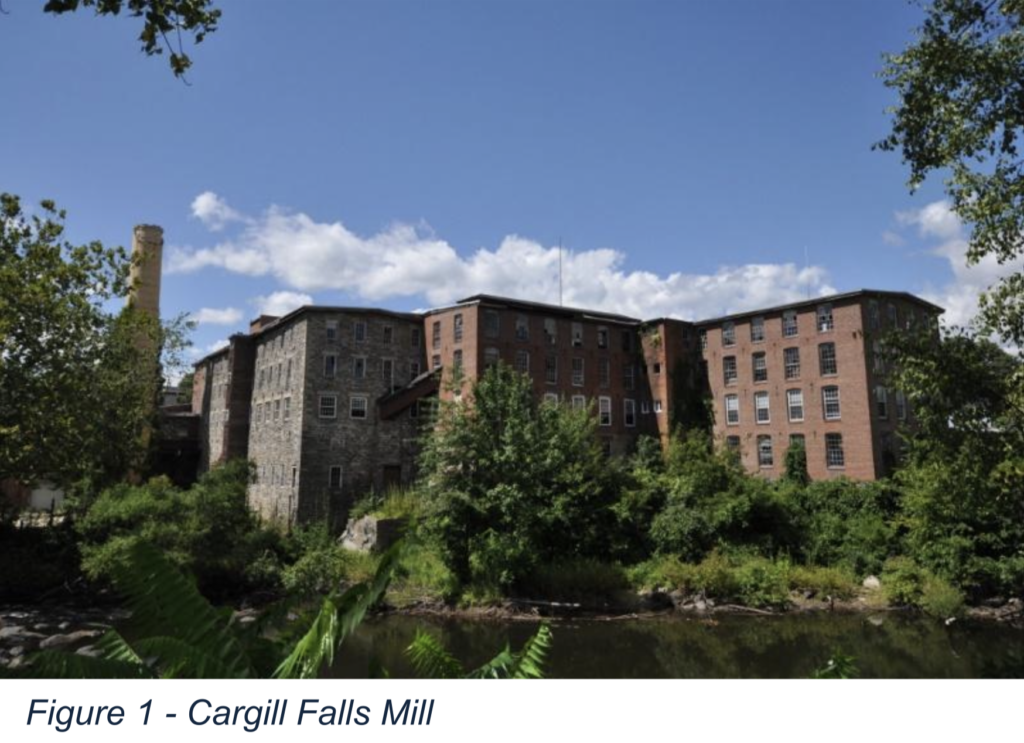What Happened?
EPA ordered a property owner of an apartment complex in a renovated old factory in Connecticut to assess and clean up lead-based paint hazards after the agency determined the hazards “may present an imminent and substantial endangerment” to tenants. The agency acted pursuant to the Resource Conservation and Recovery Act (RCRA) as a backstop when the local health department lacked authority to address units where no young children lived. Based on lead testing performed by the property owner’s consultant, EPA found that 47 of 71 units and 20 common areas had lead-based paint hazards, with lead-dust hazards1 in 20 of those units and 3 of the common areas.
The complex was an old factory in Putnam, CT, called the “Lofts at Cargill Falls Mill” that had been renovated into 82 residential units and opened in November 2020. State and local grants and tax credits supported the renovation. The developer has renovated more than five million ft2 of other mills in New England.
Two years after the complex opened, the local health department investigated the residence of a young child with an elevated blood-lead level. In December 2022, it ordered the property owner to abate lead-based paint hazards in the child’s residence and some common areas after it found extraordinarily high levels of lead in some of the units, and it notified all tenants of the risk. A month later, the agency issued a second order for the remaining eight child-occupied units.
It appears that the tenants may have prompted EPA to intervene. According to an article in The Guardian, when tenants learned of the lead contamination, some alerted EPA’s regional office in Boston (Region 1), formed a tenants union, and held a rent strike to press for action on the entire complex.
Why it Matters
EPA has broad and powerful authority under § 7003 of RCRA to quickly protect people from solid waste that may present imminent and substantial endangerment. It can issue orders, assess fines, and go to court to force action. Many states have similar authority.2 Anything other than intact lead-based paint can be considered solid waste if it is separated from the wall or is a dust-lead hazard.
Where EPA and a state are not acting diligently to address solid waste that may present an imminent and substantial endangerment, citizens can sue in federal district court under § 7002 of RCRA against anyone who contributed to the threat in order to clean-up the solid waste. They must first give notice to the parties, as well as EPA and the state, and wait at least 90 days to file the lawsuit. If successful, the citizens can recover litigation costs.
Our Take
We applaud EPA Region 1 for using its RCRA authorities to protect these tenants and encourage states and other EPA regions to follow suit to protect people from lead-based paint hazards.
While uncommon, EPA’s use of RCRA to address lead-based paint hazards is not without precedent. The agency previously used its § 7003 RCRA authority in 2000 to clean up a 77-unit, multifamily, residential building in Washington, DC.3 A year later, it acted to clean up a commercial building where a contractor had sand-blasted the exterior of an old, three-story building in Fall River, MA.4 One of the tenants was preparing to open a dance studio catering primarily to children.
Where government agencies are unwilling or hesitant to act, we encourage organizations that protect tenants from unsafe housing to consider leveraging their authority to file citizen suits under RCRA § 7002 to force action. The notice alone is a powerful tool to draw attention to the issue without obligating the citizens to go to court.
In a 2006 article in the Journal of Poverty Law and Policy, Unleaded Kids’ Tom Neltner describes these cases, the law, and how he successfully used a citizen suit strategy in Indiana.
Our Questions About EPA’s Action
EPA’s action raises questions worth considering for those who want to leverage it in their community:
- Wouldn’t the deteriorated paint and the dust be exempt from RCRA as household hazardous waste? No. The exemption only applies if the solid waste is safely managed. In this case, the deteriorated paint and lead dust were uncontrolled and not being safely managed.
- How extensive do lead-based paint hazards need to be to trigger action under RCRA? EPA did not provide clear criteria for action. The local health department acted after finding extraordinarily high dust-lead levels in the child-occupied units. In EPA’s risk assessment of the other units, as described earlier in this blog, it provided the number of occurrences but not how high the dust-lead levels were.
- Why didn’t EPA or the state use its authority under its Lead-Safe Renovation, Repair, and Painting (RRP) Rule since the renovation of the old factory into residential housing appears to have violated the requirement? We don’t know for certain, but § 7003 of RCRA likely enabled the agency to move more quickly and decisively, since it did not have to prove a violation of those RRP work practice requirements.
- Will EPA investigate the other factories renovated by the developer? EPA’s announcement made no reference to a broader investigation into the developer’s renovations in five million ft2 of other factories in New England. We encourage the agency to do so.
- Why does the Connecticut legislature not allow the health department to order clean up where housing is not child-occupied? We don’t know but have seen similar restrictions in many other states. We encourage states to allow orders to cover all units since dust-lead hazards can be carried between units through normal movement and children could move into any unit in the future. The goal is to prevent exposure not simply react to it.
Next Steps
EPA’s order provides detailed steps that the property owner must follow and requires that all hazards be abated by September 30, 2024. In addition, the property owner “shall conduct visual inspections and lead dust wipe tests for all units where lead dust and lead-based paint hazards were identified” annually for five years and submit the information to EPA. If hazards are found, the owner must conduct a risk assessment.
- Under current EPA regulations, a dust-lead hazard is surface dust in a residential dwelling or child-occupied facility that contains a mass-per-area concentration of lead equal to or exceeding 10 micrograms per square foot (µg/ft2) on floors or 100 µg/ft2 on interior window sills based on wipe samples. ↩︎
- EPA delegates primary responsibility to states for implementing RCRA where it finds a state’s program is at least as stringent as the federal requirements. EPA has delegated authority to 50 states and territories. ↩︎
- In re 17th Street Revocable Trust, No. RCRA-3-2000-0001TH. ↩︎
- Group I Management and L275 LLC of Fall River, Massachusetts, No. RCRA 01-2001-0072. ↩︎

